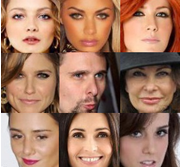Sistema de reconocimiento facial sin reentrenamiento para nuevos usuarios
Main Article Content
Keywords
Deep learning, reconocimiento facial, sistemas embebidos, systemsFaceNet, FaceNetGoogLeNet, Labeled Faces in the Wild
Resumen
El aprendizaje profundo se ha vuelto cada vez más popular y se aplica ampliamente a los sistemas de visión por computadora. A lo largo de los años, los investigadores han desarrollado varias arquitecturas de aprendizaje profundo para resolver diferentes tipos de problemas. Sin embargo,
estas redes consumen mucha energía y requieren computación de alto rendimiento (es decir, GPU, TPU, etc.) para funcionar correctamente. Mover la computación a la nube puede resultar en problemas de tráfico, latencia y privacidad. La computación en el borde puede resolver estos desafíos, pues permite acercar el proceso de computación al lugar donde se generan los datos. Un desafío importante es adaptar las altas demandas de recursos del aprendizaje profundo a dispositivos de computación de borde menos potentes. En esta investigación, presentamos una implementación de un
sistema de reconocimiento facial integrado en una Raspberry Pi de bajo costo, la cual está basada en la red FaceNet. Esta implementación requirió el desarrollo de una biblioteca en C++ que puede describir la inferencia de
la arquitectura de la red neuronal FaceNet. El sistema tuvo una exactitud y precisión de 77.38% y del 81.25 %, respectivamente. El tiempo de ejecución de cada inferencia es de 11 segundos y consume 46 [kB] de RAM. El sistema resultante podría utilizarse como un sistema de control de acceso independiente. El modelo y la librería implementados están disponibles en https://github.com/cristianMiranda-Oro/FaceNet_EmbeddedSystem.
Descargas
Referencias
[2] F. Schroff, D. Kalenichenko, and J. Philbin, “Facenet: A unified embedding for face recognition and clustering,” in Proceedings of the IEEE conference on computer vision and pattern recognition, 2015, pp. 815–823.
[3] G. B. Huang, M. Ramesh, T. Berg, and E. Learned-Miller, “Labeled faces in the wild: A database for studying face recognition in unconstrained environments,” University of Massachusetts, Amherst, Tech. Rep. 07-49, October 2007. https://hal.inria.fr/inria-00321923/file/Huang_long_eccv2008-lfw.pdf
[4] J. Deng, J. Guo, N. Xue, and S. Zafeiriou, “Arcface: Additive angular margin loss for deep face recognition,” in Proceedings of the IEEE/CVF Conference on Computer Vision and Pattern Recognition (CVPR), June 2019.
[5] X. Zhang, Z. Fang, Y. Wen, Z. Li, and Y. Qiao, “Range loss for deep face recognition with long-tailed training data,” in Proceedings of the IEEE International Conference on Computer Vision (ICCV), Oct 2017. https://arxiv.org/pdf/1611.08976.pdf
[6] J. Benito-Picazo, E. Domínguez, E. J. Palomo, E. López-Rubio, and J. M. Ortiz-de Lazcano-Lobato, “Deep learning-based anomalous object detection system powered by microcontroller for ptz cameras,” in 2018 International Joint Conference on Neural Networks (IJCNN). IEEE, 2018, pp. 1–7. https://doi.org/10.1109/IJCNN.2018.8489437
[7] S. Voghoei, N. Hashemi Tonekaboni, J. G. Wwallace, and H. R. Arabnia, “Deep learning at the edge,” 2018 International Conference
on Computational Science and Computational Intelligence (CSCI), 2018. https://doi.org/10.1109/csci46756.2018.00177
[8] V. A, D. Hebbar, V. S., K. Balasubramanya, Murthy, and N. Subramanyam, “Two novel detector-descriptor based approaches for face recognition using sift and surf,” Procedia Computer Science, vol. 70, pp. 185–197, 12 2015. https://doi.org/10.1016/j.procs.2015.10.070
[9] Y. Kortli, M. Jridi, A. Falou, and M. Atri, “Face recognition systems: A survey,” Sensors, vol. 20, p. 342, 01 2020. https://doi.org/10.3390/s20020342
[10] M. Annalakshmi, S. M. M. Roomi, and A. S. Naveedh, “A hybrid technique for gender classification with slbp and hog features,” Cluster Computing, vol. 22, no. S1, pp. 11–20, 2018. https://doi.org/10.1007/s10586-017-1585-x
[11] M. XI, L. Chen, D. Polajnar, and W. Tong, “Local binary pattern network: A deep learning approach for face recognition,” in 2016 IEEE international conference on Image processing (ICIP). IEEE, 2016, pp. 3224–3228.
[12] O. A. Arigbabu, S. M. Syed Ahamad, W. A. Wan Adnan, and S. Mahmood, “Soft biometrics: Gender recognition from unconstrained face images using local feature descriptor,” Journal of Information and Communication Technology, 2015.
[13] R. Koshy and A. Mahmood, “Optimizing deep cnn architectures for face liveness detection,” Entropy, vol. 21, no. 4, p. 423, 2019. 101
[14] L. Song, D. Gong, Z. Li, C. Liu, and W. Liu, “Occlusion robust face recognition based on mask learning with pairwise differential siamese network,” 2019 IEEE/CVF International Conference on Computer Vision (ICCV), 2019. https://doi.org/10.1109/iccv.2019.00086
[15] M. D. Zeiler and R. Fergus, “Visualizing and understanding convolutional networks,” 2013.
[16] C. Szegedy, W. Liu, Y. Jia, P. Sermanet, S. Reed, D. Anguelov, D. Erhan, V. Vanhoucke, and A. Rabinovich, “Going deeper with convolutions,” 2015 IEEE Conference on Computer Vision and Pattern Recognition (CVPR), 2015. https://doi.org/10.1109/cvpr.2015.7298594
[17] M. Schultz and T. Joachims, “Learning a distance metric from relative comparisons,” in Advances in Neural Information Processing
Systems, S. Thrun, L. Saul, and B. Schölkopf, Eds., vol. 16. MIT Press, 2004. https://proceedings.neurips.cc/paper/2003/file/d3b1fb02964aa64e257f9f26a31f72cf-Paper.pdf
[18] K. Q. Weinberger and L. K. Saul, “Distance metric learning for large margin nearest neighbor classification,” J. Mach. Learn. Res., vol. 10, pp. 207–244, Jun. 2009. https://doi.org/10.5555/1577069.1577078
[19] L. Wolf, T. Hassner, and I. Maoz, “Face recognition in unconstrained videos with matched background similarity,” CVPR 2011, 2011. https://doi.org/10.1109/cvpr.2011.5995566
[20] Z. Liu, P. Luo, X. Wang, and X. Tang, “Deep learning face attributes in the wild,” 2015.
[21] P. Viola and M. Jones, “Robust real-time face detection,” in Proceedings Eighth IEEE International Conference on Computer Vision. ICCV 2001, vol. 2, 2001, pp. 747–747. https://doi.org/10.1109/iccv.2001.937709
[22] G. Bradski, “The OpenCV Library,” Dr. Dobb’s Journal of Software Tools, 2000.
[23] Coursera. Neural networks and deep learning. https://www.coursera.org/learn/neural-networks-deep-learning
[24] GitHub. onednn: Understanding memory formats. https://oneapi-src.hub.
io/oneDNN/dev_guide_understanding_memory_formats.html
[25] C. M. Orostegui. Facenet_embeddedsystem. https://github.com/cristianMiranda-Oro/FaceNet_EmbeddedSystem 107
[26] J. A. Hanley and B. J. McNeil, “A method of comparing the areas under receiver operating characteristic curves derived from the
same cases.” Radiology, vol. 148, no. 3, pp. 839–843, 1983. https://doi.org/10.1148/radiology.148.3.6878708
[27] B. Hanczar, J. Hua, C. Sima, J. Weinstein, M. Bittner, and E. R. Dougherty, “Small-sample precision of roc-related estimates,” Bioinformatics, vol. 26, no. 6, pp. 822–830, 2010. https://doi.org/10.1093/bioinformatics/btq037


